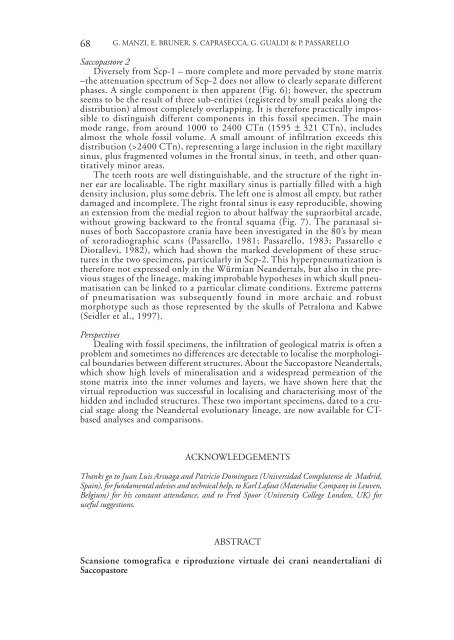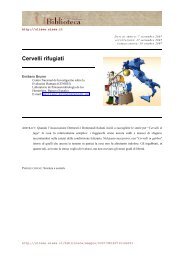Spedini_05 Bruner - Emiliano Bruner
Spedini_05 Bruner - Emiliano Bruner
Spedini_05 Bruner - Emiliano Bruner
You also want an ePaper? Increase the reach of your titles
YUMPU automatically turns print PDFs into web optimized ePapers that Google loves.
68<br />
G. MANZI, E. BRUNER, S. CAPRASECCA, G. GUALDI & P. PASSARELLO<br />
Saccopastore 2<br />
Diversely from Scp-1 – more complete and more pervaded by stone matrix<br />
–the attenuation spectrum of Scp-2 does not allow to clearly separate different<br />
phases. A single component is then apparent (Fig. 6); however, the spectrum<br />
seems to be the result of three sub-entities (registered by small peaks along the<br />
distribution) almost completely overlapping. It is therefore practically impossible<br />
to distinguish different components in this fossil specimen. The main<br />
mode range, from around 1000 to 2400 CTn (1595 ± 321 CTn), includes<br />
almost the whole fossil volume. A small amount of infiltration exceeds this<br />
distribution (>2400 CTn), representing a large inclusion in the right maxillary<br />
sinus, plus fragmented volumes in the frontal sinus, in teeth, and other quantitatively<br />
minor areas.<br />
The teeth roots are well distinguishable, and the structure of the right inner<br />
ear are localisable. The right maxillary sinus is partially filled with a high<br />
density inclusion, plus some debris. The left one is almost all empty, but rather<br />
damaged and incomplete. The right frontal sinus is easy reproducible, showing<br />
an extension from the medial region to about halfway the supraorbital arcade,<br />
without growing backward to the frontal squama (Fig. 7). The paranasal sinuses<br />
of both Saccopastore crania have been investigated in the 80’s by mean<br />
of xeroradiographic scans (Passarello, 1981; Passarello, 1983; Passarello e<br />
Diotallevi, 1982), which had shown the marked development of these structures<br />
in the two specimens, particularly in Scp-2. This hyperpneumatization is<br />
therefore not expressed only in the Würmian Neandertals, but also in the previous<br />
stages of the lineage, making improbable hypotheses in which skull pneumatisation<br />
can be linked to a particular climate conditions. Extreme patterns<br />
of pneumatisation was subsequently found in more archaic and robust<br />
morphotype such as those represented by the skulls of Petralona and Kabwe<br />
(Seidler et al., 1997).<br />
Perspectives<br />
Dealing with fossil specimens, the infiltration of geological matrix is often a<br />
problem and sometimes no differences are detectable to localise the morphological<br />
boundaries between different structures. About the Saccopastore Neandertals,<br />
which show high levels of mineralisation and a widespread permeation of the<br />
stone matrix into the inner volumes and layers, we have shown here that the<br />
virtual reproduction was successful in localising and characterising most of the<br />
hidden and included structures. These two important specimens, dated to a crucial<br />
stage along the Neandertal evolutionary lineage, are now available for CTbased<br />
analyses and comparisons.<br />
ACKNOWLEDGEMENTS<br />
Thanks go to Juan Luis Arsuaga and Patricio Dominguez (Universidad Complutense de Madrid,<br />
Spain), for fundamental advises and technical help, to Karl Lafaut (Materialise Company in Leuven,<br />
Belgium) for his constant attendance, and to Fred Spoor (University College London, UK) for<br />
useful suggestions.<br />
ABSTRACT<br />
Scansione tomografica e riproduzione virtuale dei crani neandertaliani di<br />
Saccopastore



